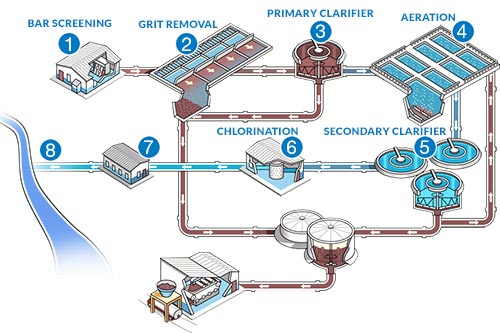Residential Water Treatment System Things To Know Before You Buy
Table of ContentsResidential Water Treatment System Things To Know Before You BuyTop Guidelines Of Residential Water Treatment SystemGet This Report about Residential Water Treatment SystemGetting My Residential Water Treatment System To Work

on the various other hand, originates from manufacturing, commercial as well as industrial tasks lugged and also has an entirely different make-up than sewer water. How does it function? The very first step in this water therapy plant is that the wastewater drains to the plant with the help of gravity via the primary drain system.
In this phase, the water moves via the gravel chamber to remove any kind of grit. The gravel is after that thrown away at the dump. The water then relocates to the bar screens which remove large objects. These are course displays. Next off, the great screens get rid of smaller sized items such as undigested foods, or matches, etc.
In this stage, the water streams to the key settling tanks, likewise recognized as pre-settling basins. These tanks have hoppers which are located in the base of the storage tank where water flows via.
Residential Water Treatment System - The Facts
These clearing up storage tanks enable the sludge to settle and after that moves to digestion containers. In the digestion storage tanks, the sludge is heated and also mixed. One more important thing that takes place below is the manufacturing of biogas, which the wastewater treatment plants can recycle, in the production of electric or thermal energy which is an additional huge advantage to the atmosphere.

The last action in wastewater therapy is examination. This evaluation includes examining the contamination level of the water dealt with and also making certain it complies with the highest standards in order to be launched or reused for domestic or industrial functions. residential water treatment system. Applications: A lot of oil refineries or petrochemical along with chemical industries create a huge quantity of wastewater and also call for on-site wastewater therapy plants.
The wastewater here streams via screens and into settlement basins that can get particles in big quantities. It functions as a pre-treatment as specified above as it occurs before three more aggressive stages- primary, secondary and tertiary treatment. Primary Therapy During this phase, the wastewater relocates right into the clarifiers.
3 Easy Facts About Residential Water Treatment System Explained
It is the design of these tanks that cause resolving, that is, the organic strong matter accumulates at the bottom of the tank while the lighter matter floats to the leading becoming easier for removal. The raw material that resolves at the base is understood as a primary sludge covering.
Second Treatment This treatment stage is composed of cardio oygenation. When this air flows via the aerators, the small openings existing, turn them into bubbles and they get blended with the water column.
This RAS goes back right into the key clarification container and also the microorganisms in it assists in breaking down any type of natural issue in the sewer. Once RAS has totally experienced both the primary as well as second information containers continually, i. official statement e several times, it is become waste-activated sludge (WAS). The WAS after that does not go back to the primary explanation tank however rather moves to the covered containers, additionally called cardiovascular sludge digesters.
Ultimately, the continuing to be sludge transfer to the dewatering facility that contains dewatering storage tanks where the plant uses belt presses to squeeze any staying water out of the sludge. Tertiary Therapy Tertiary treatment complies with the procedure of both main and secondary processes but also in enhancement entails mechanical and also photochemical processes.
Some Known Questions About Residential Water Treatment System.
Here the focus is provided to physical strategies such as screening, sedimentation, filtering, clarification etc. The purpose of this is to remove as much strong physical matters as feasible prior to sending the effluent for more treatment. This stage includes the elimination of strong waste and raw material. Here chemicals are included in break down any solid and chemical waste.
There are 2 sorts of materials- one is an anion one while the various other is a cation one. These previous materials launch hydroxyl ions which are adversely charged while the cation resins launch hydrogen ions that are favorably charged. The cation-exchange resins bring about softening of water, the anion-exchange lead to the removal of nitrate from wastewater and the mix of both the anion as well as cation exchange removes essentially every ionic contaminant Source existing in the feed water with a process called deionization (residential water treatment system).
Applications: Demineralization results in the complete elimination of minerals from the water and is normally utilized in industries that require water with high degrees of purity, for instance- makeup or feed water in high-pressure boilers, the food and also drink sector, and also procedure streams used in the production of electronics. They are likewise made use of in sectors for the generation of heavy steam, power as well as cooling.
Reverse Osmosis (RO) Water Therapy The concept of reverse osmosis (RO) works on the filtration approach that causes the removal of a a great deal of pollutants as well as pollutants from wastewater by applying stress to it when it gets on one side of a membrane. How does it function? This water therapy plant functions by utilizing a high-pressure pump that enhances the pressure on the salt side of the RO and forces the water throughout the semipermeable RO membrane (which allows some atoms and also particles to pass however not others), leaving practically 95%-99% of why not try these out dissolved salts in the decline stream.